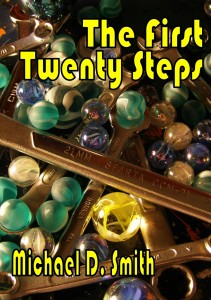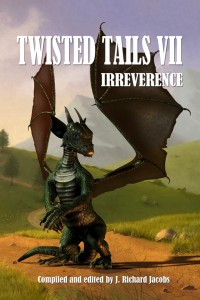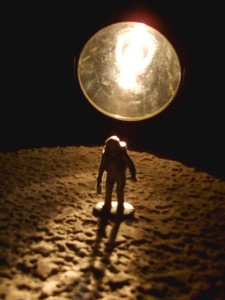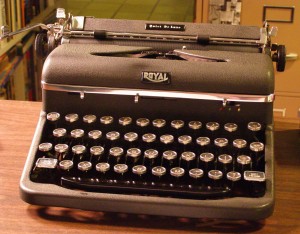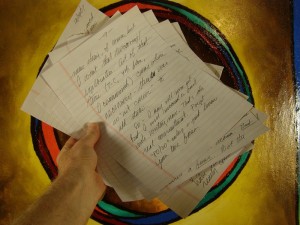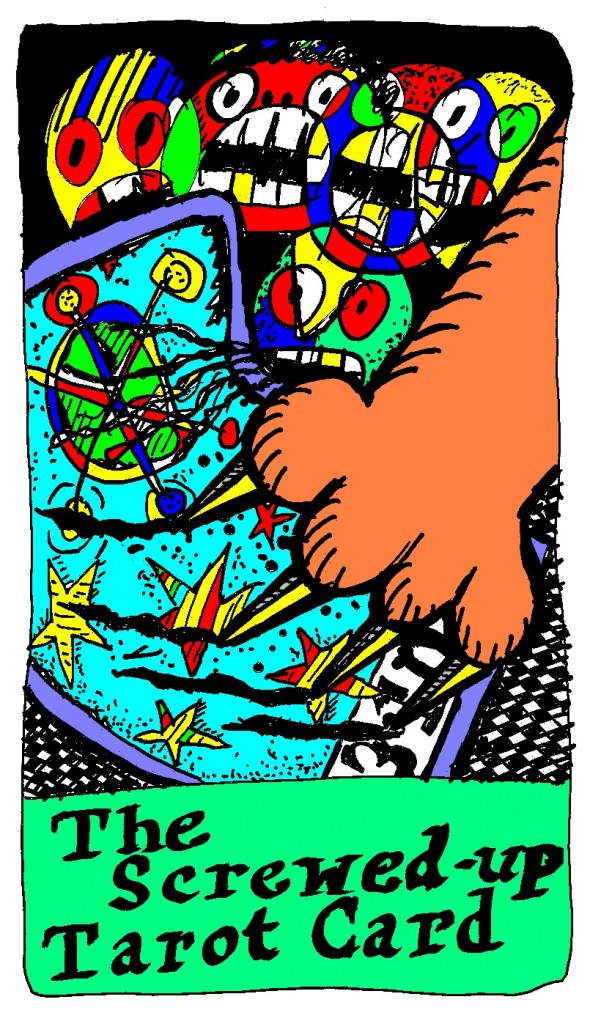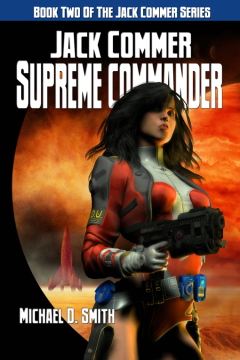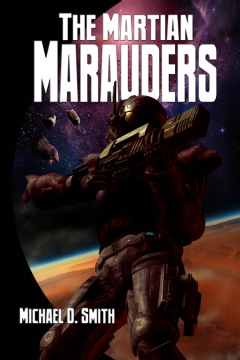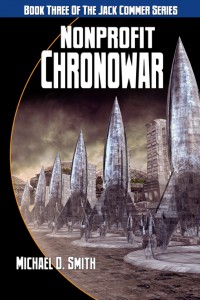 The third book of the Jack Commer series, Nonprofit Chronowar, is now available from Double Dragon Publishing in numerous eBook formats including EPUB, MOBI (Kindle format), PDF, and HTML, as well as in a paperback edition.
The third book of the Jack Commer series, Nonprofit Chronowar, is now available from Double Dragon Publishing in numerous eBook formats including EPUB, MOBI (Kindle format), PDF, and HTML, as well as in a paperback edition.
The Overview
Ranna Kikken creates The Committee to End Suffering on Planet Earth, but its first conference in 2020 is ruined when ex-astronaut Joe Commer time travels from 2036 to lecture Ranna’s nonprofit ladies on the coming breakdown of the solar system. Tormented by his role in dropping the superbomb that ended the Final War but rendered Earth uninhabitable, Joe has quit the Space Force, much to the disgust of his older brother Jack, Supreme Commander of the United System Space Force. In the audience, feckless young Urside Charmouth is horrified by the revelations from the future, fearing that he’s harmed the timeline with his own drug-like time travel experiments. He drags his unsuspecting girlfriend, Mandy, on an irresponsible time travel romp to 2033, where he finds proof of the coming destruction of Earth. Mandy then pulls herself and Urside to humanity’s new life on 2036 Mars, where she not only realizes that Mars is her true home, but also that she’s a reincarnation of an ancient Martian empress.
The Astonishing Cover
A few months ago, when publisher Deron Douglas asked me for any input I might have on a cover, I sent him some character descriptions of Ranna Kikken and the Russian Blue cat Churchill, another major character in the novel. I was assuming the cover would unfold more or less along the lines of the excellent Jack Commer, Supreme Commander cover. But Deron told me he started thinking about the Evacuation and then the concept came to him of the spaceships lined up ready to depart this planet forever. I was floored, not only by the 1950’s spaceship motif that also found its way to the Jack Commer cover, but by the fact that this cover fully evokes my own vision of the opening scene for a hypothetical Nonprofit Chronowar movie, a scene hammering in the guilt Joe Commer keeps returning to in the third novel.
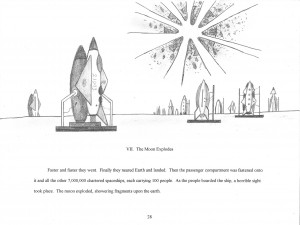 As semi-proof of this outrageous claim, consider this panel from my ongoing illustration of my sixth grade “novel,” all of twenty pages, Trip to Mars–yes, the Jack Commer universe extends back that far! A vision of the spaceships lined up to flee the end of the world–which I’ve never communicated to anyone. I’ve envisioned this opening scene accompanied by Five Variants of “Dives and Lazarus” by Ralph Vaughan Williams. I’m not a classical music snob, and most references to classical music go over my head, but the first time I heard this piece I knew it was the music for my movie. However, at thirteen minutes it’s way too long for an opening soundtrack, and I’m already envisioning heated arguments with producer, cast, and crew on the set of Nonprofit Chronowar about this impossible opening scene, which begins with blue-helmeted UN soldiers forcibly removing Stayers–those who want to die on the wrecked Earth–from their ruined homes and driving them on dilapidated buses to what we finally realize is a spaceport, where we gradually see looming in front of us … thousands of spaceships spewing liquid oxygen under the ugly charcoal sky as they prepare to launch, dozens at a time … only Five Variants of “Dives and Lazarus” keeping our eardrums from being shattered by the roars of these desperate monsters revving for takeoff.
As semi-proof of this outrageous claim, consider this panel from my ongoing illustration of my sixth grade “novel,” all of twenty pages, Trip to Mars–yes, the Jack Commer universe extends back that far! A vision of the spaceships lined up to flee the end of the world–which I’ve never communicated to anyone. I’ve envisioned this opening scene accompanied by Five Variants of “Dives and Lazarus” by Ralph Vaughan Williams. I’m not a classical music snob, and most references to classical music go over my head, but the first time I heard this piece I knew it was the music for my movie. However, at thirteen minutes it’s way too long for an opening soundtrack, and I’m already envisioning heated arguments with producer, cast, and crew on the set of Nonprofit Chronowar about this impossible opening scene, which begins with blue-helmeted UN soldiers forcibly removing Stayers–those who want to die on the wrecked Earth–from their ruined homes and driving them on dilapidated buses to what we finally realize is a spaceport, where we gradually see looming in front of us … thousands of spaceships spewing liquid oxygen under the ugly charcoal sky as they prepare to launch, dozens at a time … only Five Variants of “Dives and Lazarus” keeping our eardrums from being shattered by the roars of these desperate monsters revving for takeoff.
Look for Nonprofit Chronowar: the Movie when I force my way into Hollywood and learn how to direct films.
Back to the cover again after this fantasy: what’s additionally appealing is that the silver-gray spaceships look almost transparent, evoking time travel, fading in and out between dimensions …
Origin / The Long Revision / The Title Change
The novel was painfully pulled out of the Big Whatever over a period of thirteen years. Nonprofit Ladies, as the original title went, was originally intended as a purely literary novel. I also wanted it to be a short six-month project which would pull together recent life themes, and I began sifting ideas with a method which sometimes produces stunning results and which sometimes just wastes energy on bland organizing: collecting disparate ideas written on slips of paper over the past few years, adding new ones, then sorting them across a table until something jells. I included not only the saved notes, but folders of photos, clippings, newspaper and magazine articles stretching back many years, along with idea files, recent dreams, and any older writing that attracted my attention. Before long I had seventeen stacks of notes in these categories:
- Animals–Wild / Nature / “Physics”
- Raw Tao
- Zany / Future / Sci-Fi
- Nonprofit Ladies
- Big Shared Nightmare
- Children / Beauty
- Libraries / Preservation
- Sorrow / Passion
- Art / Raw Energy / Sex
- Zen / Taoists / Science!
- Old Things–People–Society–Methods / History
- Absurd / Humor
- The Aristocracy
- Animals Interacting With Society
- Kids in Trouble
- Politics / Civilization
- Overviews
A dream coalesced the notes into a science fiction story. In the dream, I open a dull brochure and let my “cursor of attention” rest on a picture of a Houston school bus. The cursor shows the picture to be a hyperlink, and it warps me and a coworker straight there from Dallas, to that bus on a deserted Houston street. Now here’s a business opportunity, I think–to create human transport hyperlinks … we then link to Austin, where my coworker steals my car and drives north, abandoning me to a mysterious double life I’ve apparently led in Austin for some time …
So time travel became central to the novel. And somewhere during the sorting the Jack Commer science fiction series intruded, and I found that I wanted to explore some of the traumas the main characters endured in the earlier novels, especially Joe, with his guilt about having pressed the button that destroyed the Earth in 2033.
By 2003 I had a finished novel, which I thought was my best effort yet. In fact, Nonprofit Ladies became the most important novel in the series and I revised The Martian Marauders and Jack Commer, Supreme Commander to conform to the Nonprofit Ladies universe. I sent Nonprofit Ladies to a couple publishers, got a couple rejections, then inexplicably shelved it. And a couple years later I realized why.
After finishing fun revisions of the first two novels, I finally reread Nonprofit Ladies in November 2006. I had been so sure that it was the perfect book … and yet … as I moved through Chapter One, something seemed terribly … off about it. To my horror, I found I was reading something meandering, half-cooked, and even vulgar. This was a major turning point in my writing, and led me to the concept of how leaking libido can mar one’s art. While I saw that The Martian Marauders and Jack Commer were good novels because I was in heartfelt control of those books’ structures and themes, to my dismay I was finding something icky in Nonprofit Ladies, something sadly out of touch. As one small example, Ranna’s nonprofit was originally The Committee to End Bullshit on Planet Earth. Maybe good for a cheap laugh, but really, which is the better satirical name? What would a nonprofit lady really call her committee?
I don’t mean to run down my own book in a blog post. (Is that really the done thing, I wonder?) Therefore I won’t bother to catalog all the wrong aspects of that first version, although for some demented reason I’m looking forward to rereading the very first Ur-draft of the novel, 2000-2002. Suffice to say I really would have been ashamed if the original Nonprofit Ladies I’d sent queries on had somehow gotten published. I would be disowning it now.
Some of the original book’s lack of focus was undoubtedly due to starting with a literary novel and then finding that it ought to be a third Jack Commer novel. It also took me a long time to figure out that inserting characters from some of my older novels, as well as trying to cram in an ancient 1980’s short story, “Zorexians,” were just clogging up the book. Coming to grips with the structural faults of the original Nonprofit Ladies was a revelation, and after deciding that there was nevertheless a solid core to the novel, I thoroughly rewrote it, deleting huge chunks and adding huge chunks, weeding out the leaking libido, and finding the original vision I’d wanted all along, the vision I’d never been focused enough to attain until this extremely educational rewrite.
Then, in 2012, seeing The Martian Marauders published got me thinking, a lot more seriously that I had previously, about how titles are perceived by the buying public, and I realized that “Nonprofit Ladies” doesn’t really sound like a science fiction title. The women running the nonprofit organizations and their ineffectual attempts to come to terms with inexplicable solar system disasters are just a subtheme–and there are really just two nonprofit ladies I focus on anyway, Ranna Kikken and Hedrona Bhlon, the latter also having a major role in the fourth book, Collapse and Delusion. The main energy of Nonprofit Chronowar is space pilot Joe Commer’s war guilt and the United System Space Force finally realizing that it’s been fighting a war based on time travel.
So Nonprofit Chronowar gives a nod to the first chapters where Joe scolds the naïve ladies and their Committee to End Suffering on Planet Earth, but offers up the main theme of the book as well, indicating the futility of the war, which both sides know the Alpha Centaurians will lose seventeen years in the future, but which both have no choice but to fight anyway.
The fourth book, Collapse and Delusion, is also scheduled to be published by Double Dragon Publishing, and, as anyone addicted to this blog knows, I’m now working on a fifth volume, The Wounded Frontier.
The eBook of Nonprofit Chronowar is also available in Kindle format from amazon.com, and in EPUB format from Kobo, Barnes and Noble, and Apple iTunes Store. A paperback edition is available from amazon.com and Barnes and Noble.
eBook length: 224 pages
paperback length: 218 pages
Published: May 23, 2013
copyright 2013 by Michael D. Smith


